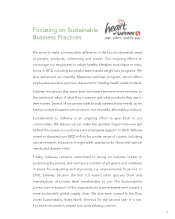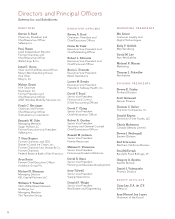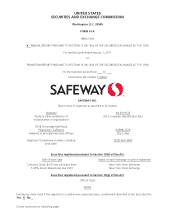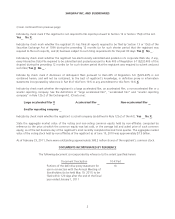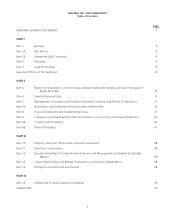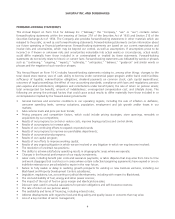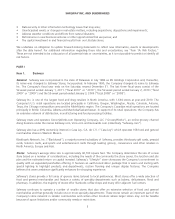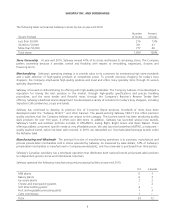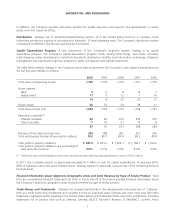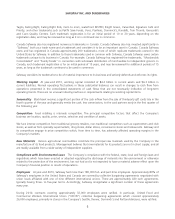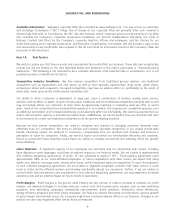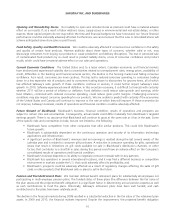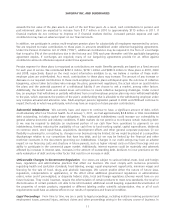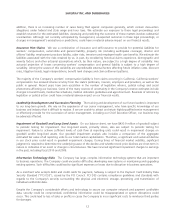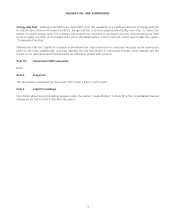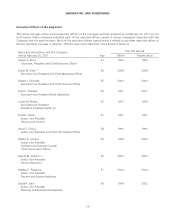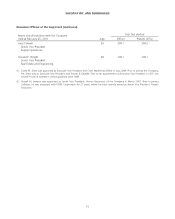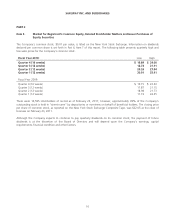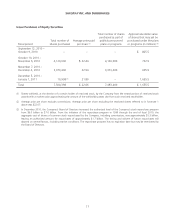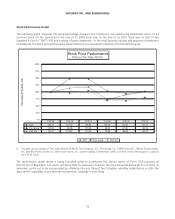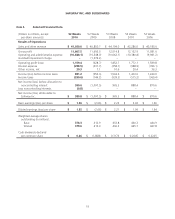Safeway 2010 Annual Report Download - page 25
Download and view the complete annual report
Please find page 25 of the 2010 Safeway annual report below. You can navigate through the pages in the report by either clicking on the pages listed below, or by using the keyword search tool below to find specific information within the annual report.SAFEWAY INC. AND SUBSIDIARIES
Available Information Safeway’s corporate Web site is located at www.safeway.com. You may access our Securities
and Exchange Commission (“SEC”) filings free of charge at our corporate Web site promptly after such material is
electronically filed with, or furnished to, the SEC. We also maintain certain corporate governance documents on our Web
site, including the Company’s Corporate Governance Guidelines, our Director Independence Standards, the Code of
Business Conduct and Ethics for the Company’s corporate directors, officers and employees, and the charters for our
Audit, Nominating and Corporate Governance, and Executive Compensation committees. We will provide a copy of any
such documents to any stockholder who requests it. We do not intend for information found on the Company’s Web site
to be part of this document.
Item 1A. Risk Factors
We wish to caution you that there are risks and uncertainties that could affect our business. These risks and uncertainties
include, but are not limited to, the risks described below and elsewhere in this report, particularly in “Forward-Looking
Statements.” The following is not intended to be a complete discussion of all potential risks or uncertainties, as it is not
possible to predict or identify all risk factors.
Competitive Industry Conditions We face intense competition from traditional grocery retailers, non-traditional
competitors such as supercenters and club stores, as well as from specialty supermarkets, drug stores, dollar stores,
convenience stores and restaurants. Increased competition may have an adverse effect on profitability as the result of
lower sales, lower gross profits and/or greater operating costs.
Our ability to attract customers is dependent, in large part, upon a combination of location, quality, price, service,
selection and condition of assets. In each of these areas, traditional and non-traditional competitors compete with us and
may successfully attract our customers to their stores by aggressively matching or exceeding what we offer. In recent
years, many of our competitors have increased their presence in our markets. Our responses to competitive pressure, such
as additional promotions and increased advertising, could adversely affect our profitability. We cannot guarantee that our
actions will succeed in gaining or maintaining market share. Additionally, we cannot predict how our customers will react
to the entrance of certain non-traditional competitors into the grocery retailing business.
Because we face intense competition, we need to anticipate and respond to changing consumer demands more
effectively than our competitors. We strive to achieve and maintain favorable recognition of our unique private-label
brands, effectively market our products to consumers, competitively price our products and maintain and enhance a
perception of value for consumers. Finally, we need to source and market our merchandise efficiently and creatively.
Failure to accomplish these objectives could impair our ability to compete successfully and adversely affect our growth
and profitability.
Labor Relations A significant majority of our employees are unionized, and our relationship with unions, including
labor disputes or work stoppages, could have an adverse impact on our financial results. We are a party to approximately
430 collective bargaining agreements, of which 121 are scheduled to expire in 2011. These expiring agreements cover
approximately 38% of our union-affiliated employees. In future negotiations with labor unions, we expect that rising
health care, pension and wage costs, among other issues, will be important topics for negotiation. If, upon the expiration
of such collective bargaining agreements, we are unable to negotiate acceptable contracts with labor unions, it could
result in strikes by the affected workers and thereby significantly disrupt our operations. Further, if we are unable to
control health care and pension costs provided for in the collective bargaining agreements, we may experience increased
operating costs and an adverse impact on future results of operations.
Profit Margins Profit margins in the grocery retail industry are very narrow. In order to increase or maintain our profit
margins, we develop strategies to increase revenues, reduce costs and increase gross margins, such as new marketing
programs, new advertising campaigns, productivity improvements, shrink reduction, distribution center efficiencies,
energy efficiency programs and other similar strategies. Our failure to achieve forecasted cost reductions, revenue growth
or gross margin improvement across the Company might have a material adverse effect on our business. Changes in our
product mix also may negatively affect certain financial measures.
9


